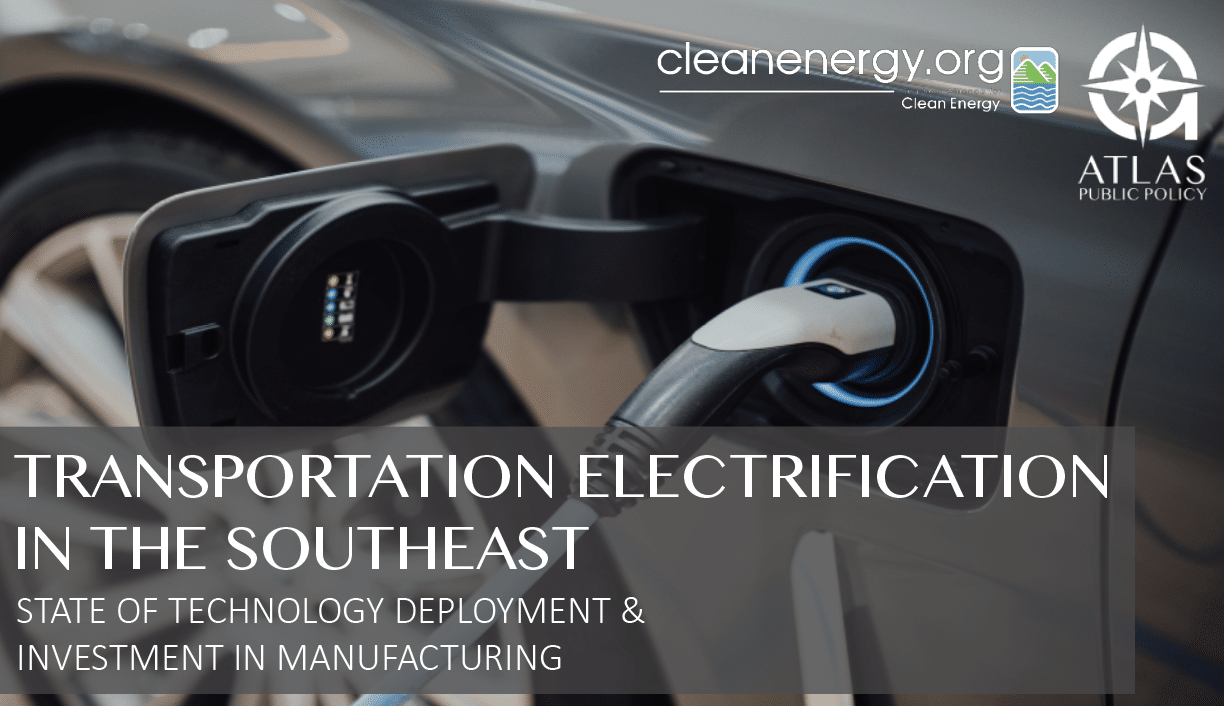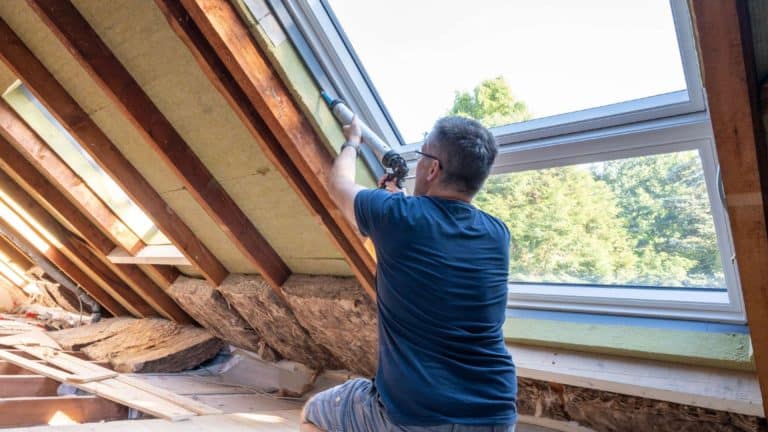With a cumulative 1.6 million passenger electric vehicles (EV) sold and investment in the EV sector on the rise, states across the country are seizing the opportunity to increase EVs and EV charging stations. Transportation electrification is taking hold in the United States across all vehicle types, including consumer vehicles, fleets, electric buses, and trucks.
To explore how Southeastern states stack up against each other, and the nation, the Southern Alliance for Clean Energy (SACE) and Atlas Public Policy have collaborated on a new brief, “Transportation Electrification in the Southeast,” which provides a snapshot of the Southeast’s EV market. The brief examines state-by-state policy, regulatory, economic development, and investment activity across Alabama, Florida, Georgia, North Carolina, South Carolina, and Tennessee.
[button color=”blue” url=”https://bit.ly/EVsinSE”]Download the Report[/button]
The Southeast Benefits from Manufacturing Job Creation and Economic Investment, But We Have Fewer EVs on our Southeastern Roads
On the one hand, the Southeast is a leader in EV manufacturing investment and job creation, accounting for a striking 28% of nation-wide manufacturing investment and at least 14% of the passenger EV manufacturing jobs while representing 18% of the U.S. population. At least $6.7 billion of $24 billion in current automakers and battery manufacturers committed investments are in the Southeast. Both investment and employment are continuing to rise, with new passenger EV models entering the market and manufacturing facilities across the region ramping up.
These statistics don’t even include the investments and job creation by medium and heavy-duty vehicle manufacturers like Daimler, Proterra, New Flyer, and Volvo that operate facilities in the region and are also ramping up electrification efforts nationwide. As this medium and heavy-duty EV and EV charger investment and jobs data become more available, the region’s sunny EV economic development picture will only brighten. Neither do the above statistics include the growing network of EV charging suppliers, manufacturers, and providers scaling their operations to meet increasing EV deployment.
On the other hand, the Southeast is lagging the nation in EV sales and charging station deployment. Again, representing 18% of the U.S. population, the region accounts for 10% of national EV sales, and 13% of EV chargers deployed. The region is also significantly underrepresented in utility and government funding for transportation electrification: the Southeast accounts for less than 1% of utility investment and only 4% of government funding nationwide.
EV Indicators in the Six States of the Southeast through August 2020
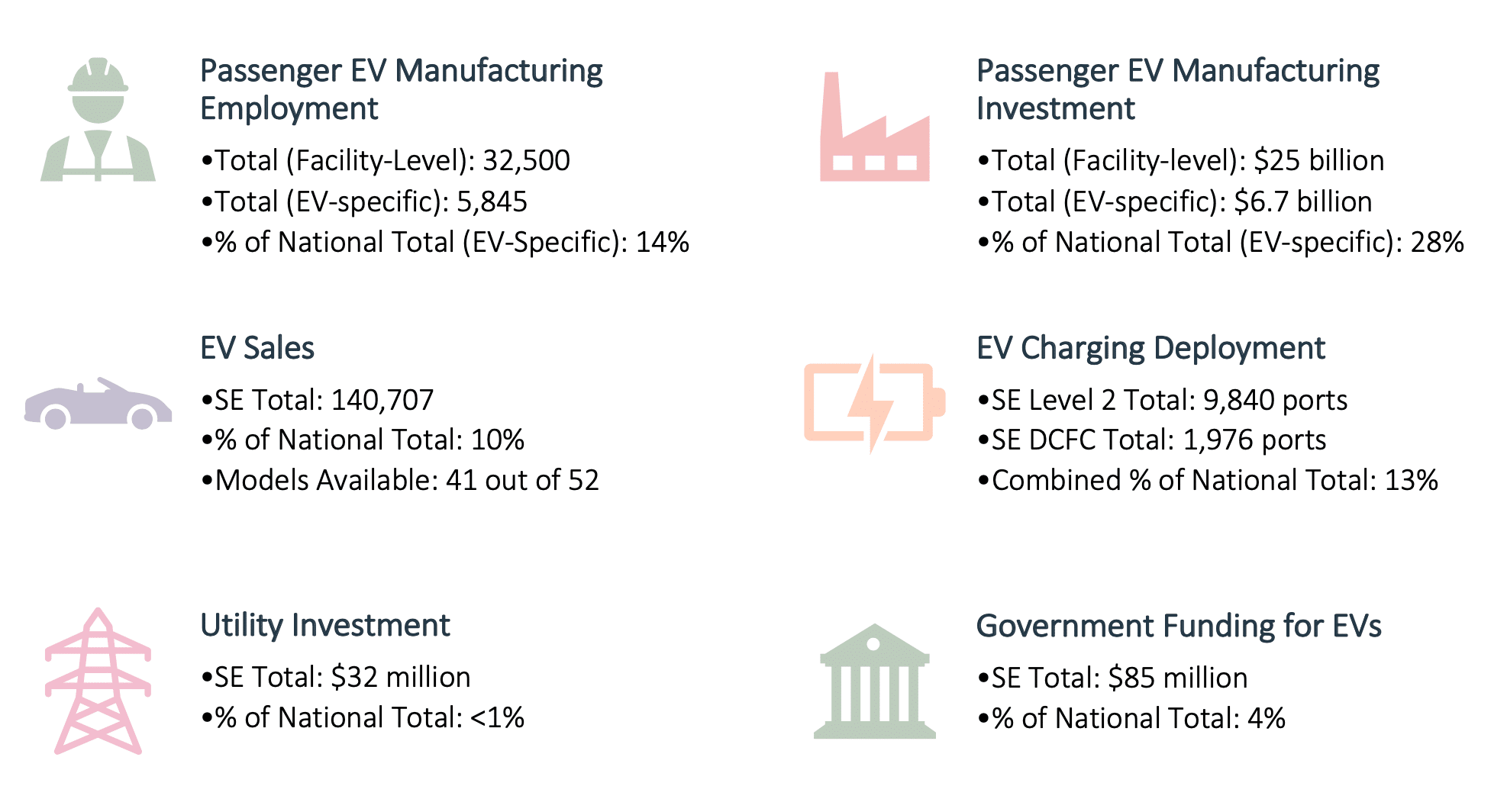
Note: Since the brief’s final editing, the Public Service Commission of South Carolina approved Duke Energy’s electric transportation pilot that aims to install public fast chargers and offer residential charging station rebates across the state. This investment is not included in the data above.
We Could Change This Pattern
EV sales vary widely by state and region, and are consistently most substantial in markets with favorable policies and engaged electric utilities. In order to truly maximize the economic development potential in the Southeast, it is critical that we work to increase consumer and fleet demand for EVs across all vehicle types. The strong Southeast light, medium, and heavy-duty EV manufacturing and supply chain base sets up the potential for a virtuous cycle. Policymakers and utility regulators can enable EV-supportive policies and utility engagement to support the region’s consumers and fleets transitioning to EVs, and also spur additional regional manufacturing and job growth.
Expanding partnerships with electric utilities can also support this transition. Regulators should encourage utilities to implement programs that address research and development, charging infrastructure deployment, rate design, and consumer education needs. Policymakers can leverage increasing utility engagement and available funding streams such as state-allocated VW Settlement funds, federal Low/No grants, and municipal bond referendums to implement effective policies that encourage consumer and fleet transportation electrification. Doing so will bolster regional manufacturing and reduce transportation costs saving consumers and taxpayers money.
The Southeast region has spent only 15% of the total $427 million allocated to the region through the Volkswagen Settlement allocation. More than 73% of the region’s government funding for transportation comes from federal sources. On the utility side, there is more than $86 million in pending utility investment awaiting approval.
By establishing a favorable policy environment and increasing utility engagement, we can signal to auto manufacturers and supply chain companies that the Southeast is a viable market for their products and impending manufacturing expansion.
The EV Market is Poised for Even More Growth
As the “Transportation Electrification in the Southeast“ brief outlines, the U.S. passenger EV market has accelerated rapidly over the last decade. More than 1.6 million vehicles have been sold nationally since the first mass-market EVs were released in 2010. Of these, approximately 1 million are all-battery electric vehicles (BEV), and 600 thousand are plug-in hybrid eclectic vehicles (PHEV). The cost of batteries fell by more than 80 percent between 2010 and 2018, and automakers like Tesla led the development of long-range EVs with all-electric ranges exceeding 300-miles. More than 52 models of EVs available on the market compared to just two in 2010, and at least 30 more are expected to be released by the end of 2021. Automakers and startups have pledged at least $64 billion to support transportation electrification in the United States.
Southeast EV Sales Follow National Trends
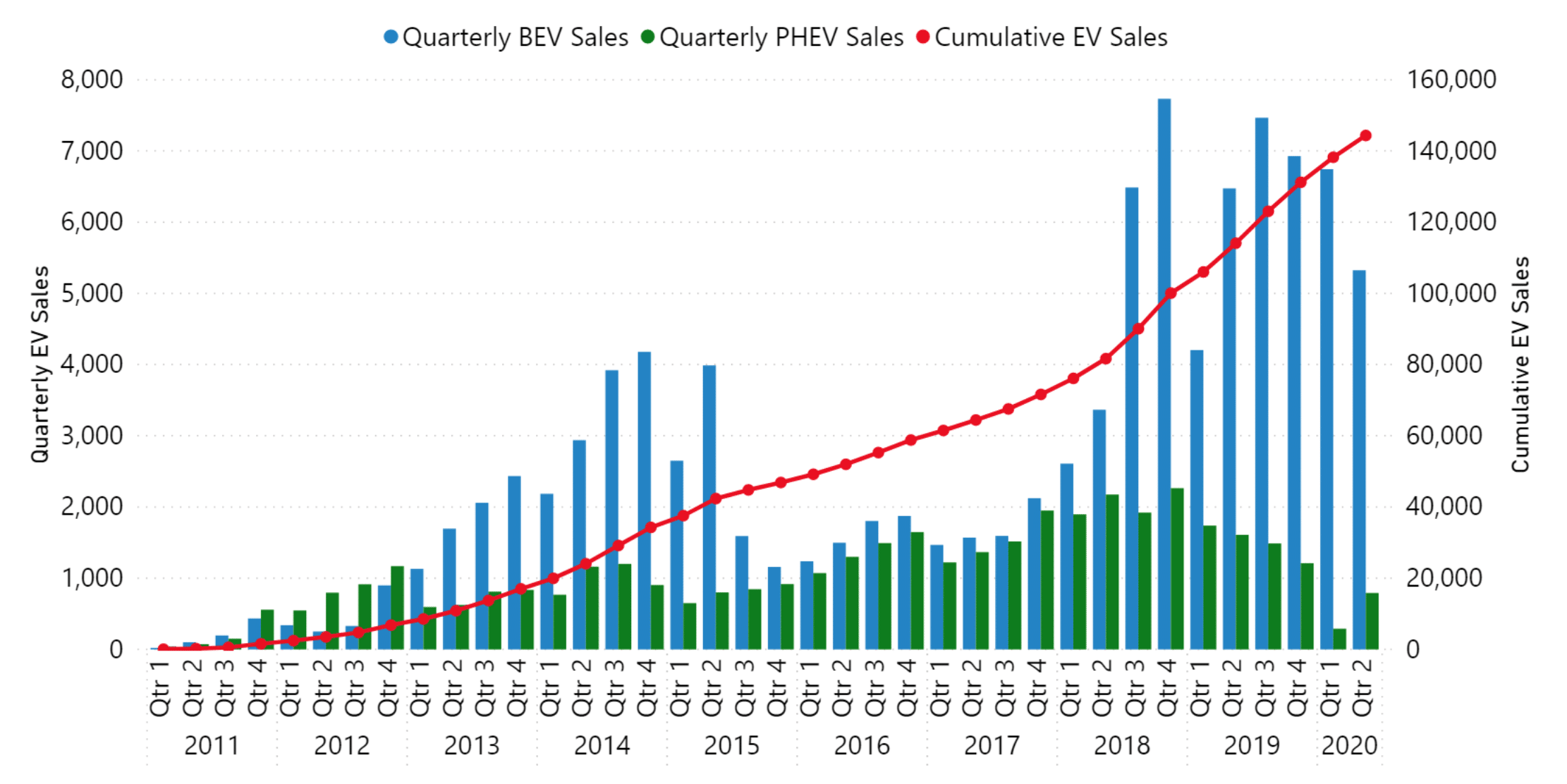
The market for EV charging infrastructure has grown in step with the vehicle market. Since the beginning of 2018, the number of charging stations nationwide has increased by almost three times. Nearly 91,000 charging ports are deployed at about 30,000 locations throughout the United States, including more than 17,500 fast charging ports. In 26 states, electric utilities have committed more than $1.8 billion to programs dedicated to EV charging since 2012. Additionally, private companies have invested roughly $2.8 billion to expand the nation’s charging networks, and the federal and state governments have allocated more than $2.1 billion to transportation electrification.
Southeast EV Charger Deployments Through Q2 2020
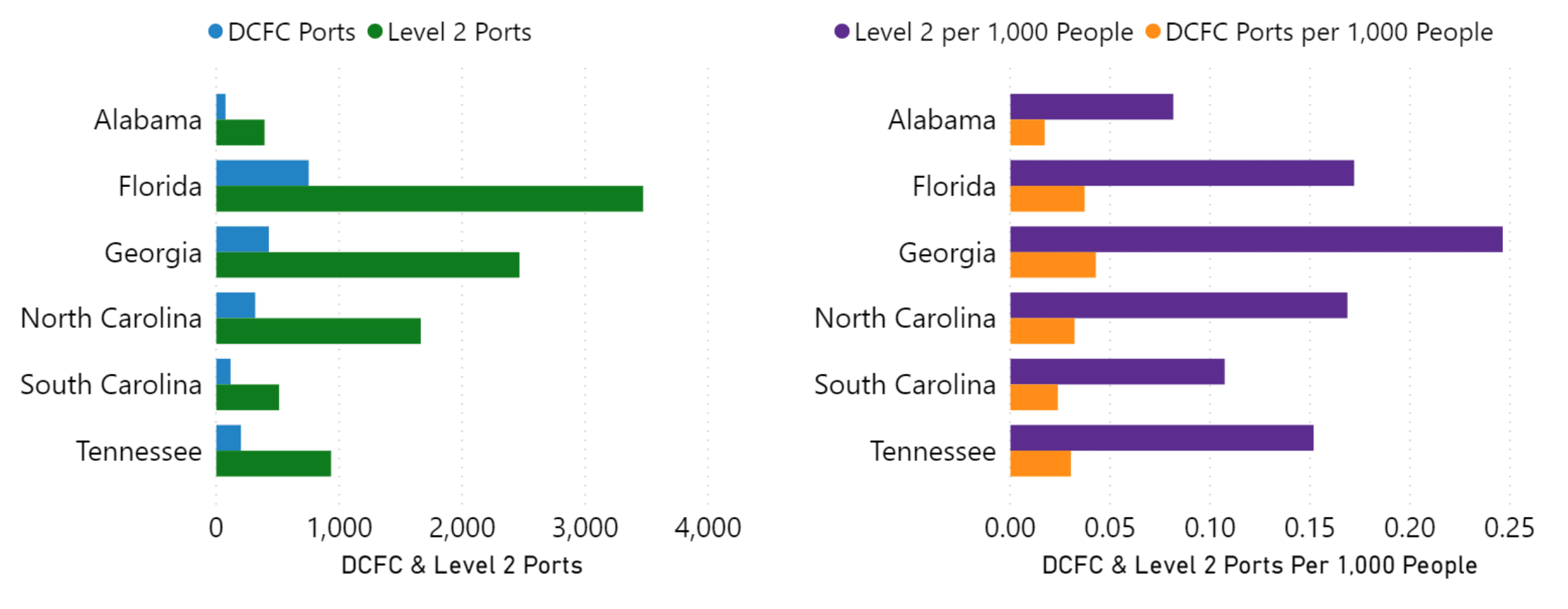
How to Scale Transportation Electrification in the Southeast: State Policy and Utility Engagement Recommendations
The strongest EV markets in the U.S. have one thing in common: they all have supportive state policies and active regulated utility engagement. The relationship between emerging technologies, policy, and regulatory intervention is nothing new—recent disruptive technologies such as broadband internet and cell phones also benefitted from government support and regulatory interventions to enable them to scale and allow consumers to reap their broad social and economic benefits. EVs are no different. Supporting electric transportation market growth with strategic policies and regulatory reforms will deliver lower-cost, lower-polluting, and better-performing transportation and mobility solutions; investments states and utilities make today will pay dividends down the road.
State Policy Opportunities
There are many ways state policymakers can support EV market growth:
Plan for a Transportation Electrification Future
- Develop state-wide EV Master Plans like Florida’s to set goals and establish priorities to guide government, utility, and private sector engagement.
- Work together with other Southeastern states to develop a regional electric transportation initiative similar to REV West. Regional collaboration will increase economic development opportunities, purchase power, and highway corridor charging build-out.
Support Consumer and Fleet Access to the Expanding EV Market
- Support direct-sales legislation that enables EVs to be available for purchase directly from the auto manufacturer in a state, as Florida and Tennessee already allow.
- Adopt Light Duty Zero Emission Vehicle (ZEV) Standards to open vehicle access to consumers and fleet operators like Minnesota, New Mexico, Nevada, and Ohio. They plan to join the other 12-states that have already signed on.
- Join the Multi-State Medium and Heavy-Duty ZEV Memorandum of Understanding to spur medium and heavy-duty EV market activity as North Carolina did.
- Institute an EV tax credit or rebate for consumers and private fleet owners like Colorado did.
- Support used car incentives to make EV ownership more accessible to a broader range of consumers, like Oregon’s program targeted at low-to-moderate income communities.
- Encourage the establishment of low-interest loan programs for consumers that include new and used EVs as Washington did.
Electrify State and Municipal Fleets
- Analyze and prioritize state government EV fleet adoption to reduce operation and maintenance expenses and save taxpayers money long-term, like North Carolina already is.
- Support and incentivize transit agencies to electrify transit buses as Greensboro, NC, and Miami-Dade County, FL have.
- Support and incentivize school bus electrification, as Virginia already is.
Support Increased EV Charger Deployment
- Establish state-wide EV make-ready building codes to reduce EV charging station installation costs and encourage deployment.
- Protect parking spaces equipped with EV chargers from being occupied by non-EVs as Arizona did.
- Empower electric utility regulators to determine appropriate principles and guidelines for utility engagement and investment like those suggested by Edison Electric Institute.
Regulated Utility Investment Opportunities
Regulated utilities in the Southeast are subject to regulatory oversight, serve the majority of the region’s customers, and possess the resources needed to support rapid EV market growth. (By contrast, electric member cooperatives (EMC) and municipal utilities operate on the electric utility regulatory structure’s fringes and have more transportation electrification engagement flexibility. They also serve only a fraction of the region’s customers and have significantly fewer resources.) Regulated utilities should be encouraged to invest resources in charging infrastructure deployment while simultaneously researching and developing rate design strategies and accounting for projected EV-related grid impacts in all resource planning.
The Regulatory Assistance Project policy guide outlines the charging infrastructure roles utilities are suited to play. Optimal solutions result from utilities engaging in all four of these roles under various circumstances, when and where doing so is beneficial to the market and consumers:
Facilitator: The utility treats EV charging like any other potential load, providing electric service when and where requested but not engaging directly in the business of vehicle charging.
Enabler: The utility deploys traditional electrical infrastructure up to the point of connection to charging stations to enable project development — also called the make-ready — but does not take a direct role in installing, owning, or operating the charging infrastructure.
Manager: In addition to delivering electric service to the vehicle charger’s location, the utility manages the charging operation to accommodate grid capabilities and grid needs.
Provider: The utility delivers electric service to the charging equipment, which the utility owns and can earn a return on, and the utility provides charging services.
There are immediate opportunities for utility action including charging infrastructure deployment gaps, research and development needs, and rate design challenges. While utility engagement should not be limited to these immediate opportunities, regulators should be encouraging and supporting utility efforts to address them:
Provide EV charging infrastructure at locations underserved by public or private sector-funded charging station deployment.
- Rural and traditionally disadvantaged communities
- Evacuation route and highway corridor charging gaps
Manage and enable EV charging where utility capabilities, capacity, and capital are needed.
- Make-ready investments for multifamily dwellings and public highway corridor fast charging
- Managed charging to research and develop vehicle-to-grid integration and distributed energy resource optimization, especially for transit and school buses and freight and delivery vehicles
Test rate-design and investment strategies to facilitate market growth such as:
- Pay-as-you-save programs for funding the capital expenditure delta between diesel and electric transit and school buses
- DCFC demand charge limiters to support private sector EV charger deployment
- Light, medium, and heavy-duty time of use rates to encourage off-peak charger utilization and other grid management priorities
To maximize the opportunities at hand, governments and regulators in the Southeast need to support consumer and fleet transitions to EVs
Our region benefits from manufacturing job creation and economic investment, but we are lacking in actual EVs on our Southeastern roads. Supportive policies and electric utility engagement are currently lagging, and by increasing and improving these, we can provide the most powerful levers for regional EV market growth. Transitioning to EVs will improve public health, address the climate crisis, and provide lower-cost transportation solutions for consumers and fleets. Perhaps most important to policymakers, transitioning to electric transportation will expand manufacturing investment and job growth in a sector the region already leads.
The Southern Alliance for Clean Energy’s ‘Electrify the South’ campaign advocates for a shift to clean, electric transportation throughout the Southeast. Visit ElectrifytheSouth.org to learn more and connect with us.
#EVsinSE

